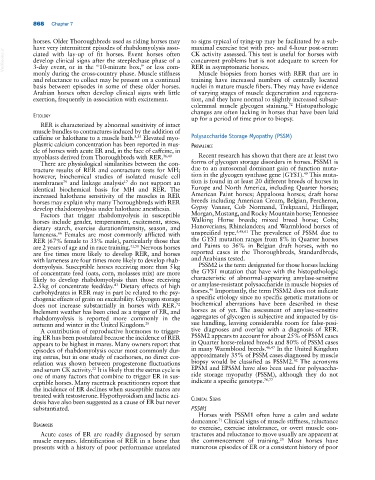Page 902 - Adams and Stashak's Lameness in Horses, 7th Edition
P. 902
868 Chapter 7
horses. Older Thoroughbreds used as riding horses may to signs typical of tying‐up may be facilitated by a sub
have very intermittent episodes of rhabdomyolysis asso maximal exercise test with pre‐ and 4‐hour post‐serum
VetBooks.ir develop clinical signs after the steeplechase phase of a concurrent problems but is not adequate to screen for
CK activity assessed. This test is useful for horses with
ciated with lay‐up of fit horses. Event horses often
RER in asymptomatic horses.
3‐day event, or in the “10‐minute box,” or less com
monly during the cross‐country phase. Muscle stiffness Muscle biopsies from horses with RER that are in
and reluctance to collect may be present on a continual training have increased numbers of centrally located
basis between episodes in some of these older horses. nuclei in mature muscle fibers. They may have evidence
Arabian horses often develop clinical signs with little of varying stages of muscle degeneration and regenera
exertion, frequently in association with excitement. tion, and they have normal to slightly increased subsar
colemmal muscle glycogen staining. Histopathologic
72
changes are often lacking in horses that have been laid
etIology
up for a period of time prior to biopsy.
RER is characterized by abnormal sensitivity of intact
muscle bundles to contractures induced by the addition of
caffeine or halothane to a muscle bath. 8,35 Elevated myo Polysaccharide Storage Myopathy (PSSM)
plasmic calcium concentration has been reported in mus PrevalenCe
cle of horses with acute ER and, in the face of caffeine, in
myoblasts derived from Thoroughbreds with RER. 36,40 Recent research has shown that there are at least two
There are physiological similarities between the con forms of glycogen storage disorders in horses. PSSM1 is
tracture results of RER and contracture tests for MH; due to an autosomal dominant gain of function muta
49
however, biochemical studies of isolated muscle cell tion in the glycogen synthase gene (GYS1). This muta
membranes and linkage analysis do not support an tion is found in at least 20 different breeds of horses in
79
17
identical biochemical basis for MH and RER. The Europe and North America, including Quarter horses;
increased halothane sensitivity of the muscles in RER American Paint horses; Appaloosa horses; draft horse
horses may explain why many Thoroughbreds with RER breeds including American Cream, Belgian, Percheron,
develop rhabdomyolysis under halothane anesthesia. Gypsy Vanner, Cob Normand, Trekpaard, Haflinger,
Factors that trigger rhabdomyolysis in susceptible Morgan, Mustang, and Rocky Mountain horse; Tennessee
horses include gender, temperament, excitement, stress, Walking Horse breeds; mixed breed horse; Cobs;
dietary starch, exercise duration/intensity, season, and Hanoverians; Rhinelanders; and Warmblood horses of
lameness. Females are most commonly afflicted with unspecified type. 5,48,61 The prevalence of PSSM due to
66
RER (67% female to 33% male), particularly those that the GYS1 mutation ranges from 8% in Quarter horses
are 2 years of age and in race training. 41,50 Nervous horses and Paints to 36% in Belgian draft horses, with no
are five times more likely to develop RER, and horses reported cases in the Thoroughbreds, Standardbreds,
with lameness are four times more likely to develop rhab and Arabians tested.
domyolysis. Susceptible horses receiving more than 5 kg PSSM2 is the term designated for those horses lacking
of concentrate feed (oats, corn, molasses mix) are more the GYS1 mutation that have with the histopathologic
likely to develop rhabdomyolysis than those receiving characteristic of abnormal‐appearing amylase‐sensitive
2.5 kg of concentrate feed/day. Dietary effects of high or amylase‐resistant polysaccharide in muscle biopsies of
43
46
carbohydrates in RER may in part be related to the psy horses. Importantly, the term PSSM2 does not indicate
chogenic effects of grain on excitability. Glycogen storage a specific etiology since no specific genetic mutations or
72
does not increase substantially in horses with RER. biochemical aberrations have been described in these
Inclement weather has been cited as a trigger of ER, and horses as of yet. The assessment of amylase‐sensitive
rhabdomyolysis is reported more commonly in the aggregates of glycogen is subjective and impacted by tis
autumn and winter in the United Kingdom. 29 sue handling, leaving considerable room for false‐posi
A contribution of reproductive hormones to trigger tive diagnoses and overlap with a diagnosis of RER.
ing ER has been postulated because the incidence of RER PSSM2 appears to account for about 25% of PSSM cases
appears to be highest in mares. Many owners report that in Quarter horse‐related breeds and 80% of PSSM cases
episodes of rhabdomyolysis occur most commonly dur in many Warmblood breeds. 46,47 In the United Kingdom
ing estrus, but in one study of racehorses, no direct cor approximately 35% of PSSM cases diagnosed by muscle
62
relation was shown between progesterone fluctuations biopsy would be classified as PSSM2. The acronyms
and serum CK activity. It is likely that the estrus cycle is EPSM and EPSSM have also been used for polysaccha
22
one of many factors that combine to trigger ER in sus ride storage myopathy (PSSM), although they do not
ceptible horses. Many racetrack practitioners report that indicate a specific genotype. 76,77
the incidence of ER declines when susceptible mares are
treated with testosterone. Hypothyroidism and lactic aci
dosis have also been suggested as a cause of ER but never ClInICal sIgns
substantiated. PSSM1
Horses with PSSM1 often have a calm and sedate
demeanor. Clinical signs of muscle stiffness, reluctance
71
dIagnosIs
to exercise, exercise intolerance, or overt muscle con
Acute cases of ER are readily diagnosed by serum tractures and reluctance to move usually are apparent at
muscle enzymes. Identification of RER in a horse that the commencement of training. Most horses have
20
presents with a history of poor performance unrelated numerous episodes of ER or a consistent history of poor

